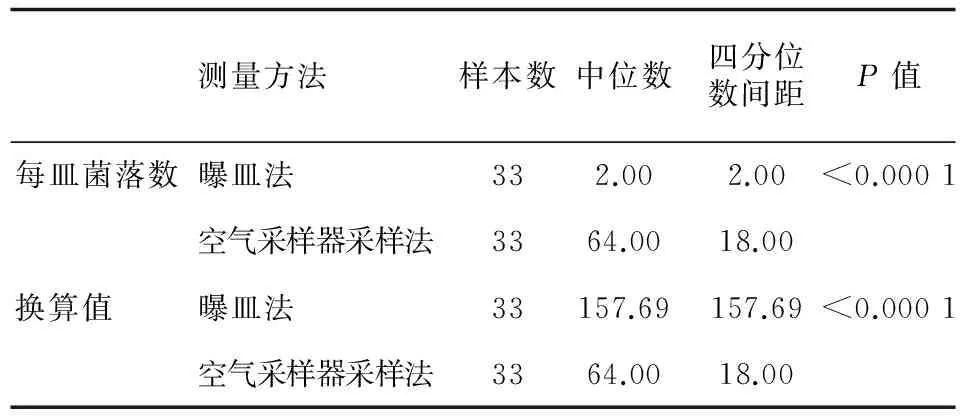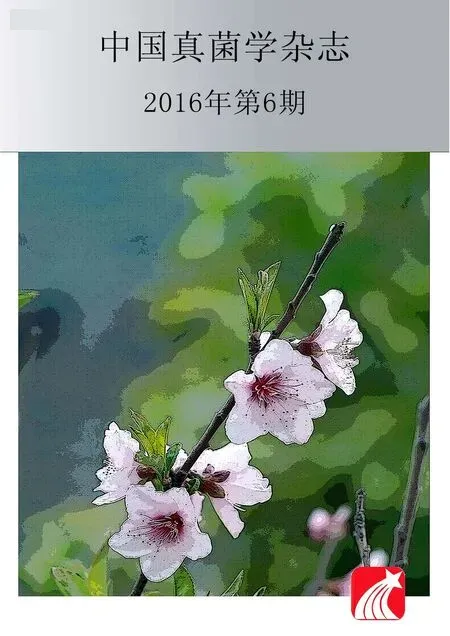上海某综合性医院秋季室内外环境空气中真菌种群分布的研究
洪南 方文捷 刘加 陈敏 潘炜华 廖万清
(第二军医大学附属长征医院皮肤科,上海长征医院皮肤病与真菌病研究所,上海市医学真菌分子生物学重点实验室,全军真菌病重点实验室,上海 200003)
·论著·
上海某综合性医院秋季室内外环境空气中真菌种群分布的研究
洪南 方文捷 刘加 陈敏 潘炜华 廖万清
(第二军医大学附属长征医院皮肤科,上海长征医院皮肤病与真菌病研究所,上海市医学真菌分子生物学重点实验室,全军真菌病重点实验室,上海 200003)
目的 监测目前上海地区某综合性医院室内外环境空气中真菌种群分布特征,为临床侵袭性真菌感染的防治提供科学依据。方法 于2015年秋季以基于微生物气溶胶采集的空气采样器采样法与曝皿法随机对上海地区某综合性三甲医院的26处室内及7处室外环境进行同步空气采样,相关样本在含有氯霉素的沙氏培养基上经培养、分离、纯化及分子鉴定后,对不同采样地点真菌种群结构予以统计学分析。结果 上海地区综合性三甲医院室内空气中青霉属 (约24.14%)在真菌种群结构中占有明显优势,室外空气中则以分枝孢子菌属占有优势 (约34.09%),青霉属在室内空气中所占比重 (约24.14%)明显高于室外 (11.09%)。结论 虽然上海地区的医疗水平国内领先,且被调查医院已按相关规定进行了日常环境消毒工作,但被调查医院室内外空气中仍被发现存在高度多样性的真菌种群结构,且包含了常见的机会致病真菌如烟曲霉等,继续加强综合性医院室内外环境中真菌等病原微生物的监测和加强院内感染的控制是非常必要的。
医院污染;室内真菌;空气采样;真菌感染
[Chin J Mycol,2016,11(6):361-365]
近30 a来,随着免疫抑制剂、化疗药物、糖皮质激素、广谱抗生素在临床的广泛应用及HIV在全球的蔓延,免疫抑制患者的数量持续增多,侵袭性真菌病的发病率、病死率逐年增加。Martinez-Marcos等[1]于1994年始进行的一项前瞻性队列研究显示:肾移植术后患者中,11%的感染为真菌源性感染。医院周围环境空气中真菌的含量、种群结构与院内真菌感染的发生有一定关联[2-3]。1994~2002年,Faure等[4]对医院部分工作环境中的真菌含量及种类进行了长达8年的监测,结果显示以念珠菌属、曲霉菌属、青霉菌属为主要病原体的院内真菌感染逐年增加。空气是真菌污染传播的重要载体[5],医院内各区域空气真菌数量的监测对控制院内感染意义重大,医院室内外环境空气中真菌的种群分布正日渐引起医学真菌学、流行病学及感染控制等领域专家的高度关注。室内空气真菌受多种因素影响,包括湿度、通气、温度、室内有机材料以及室外空气真菌负荷程度等[6-7]。多项研究结果共同提示:医院室内空气真菌负荷在不同的季节差异明显,而秋季是医院室内空气真菌负荷最高的季节[8-10]。因此,本研究在2015年秋季选取上海地区某综合性三甲医院,以目前医院周围环境微生物监测主流的曝皿法和空气采样器采样法[11]随机对该院室内外不同地点环境中的空气样本进行同步采样,相关样品经培养及分离、纯化后做分子生物学鉴定及统计学分析,旨在监测目前上海地区综合性医院室内外环境空气中的真菌种群分布特征,为临床侵袭性真菌感染的防治提供科学依据。
1 材料与方法
1.1 仪器与材料
空气采样器采样法采用基于微生物气溶胶采集的Coriolis μ型湿壁气旋式采样机 (法国Bertin公司),直径90 mm的含氯霉素的沙氏培养基平皿 (美国Becton Dickinson公司),15 mL离心管,10 mL双蒸水;曝皿法采用直径90 mm的含氯霉素的沙氏琼脂培养基平皿 (美国Becton Dickinson公司)。
1.2 采样地点
在所选医院的住院部大楼中从每个科室的病房中各随机选取出一个病房作为医院室内环境的采样地点,共26处;从门诊大楼各层及楼顶随机选取一处工作环境作为医院室外环境的采样地点,共7处 (见表1~2)。
表1 医院室外环境空气真菌采样结果
Tab.1 Airborne fungi sampling results of outdoor hospital environments

地点曝皿法空气采样器采样法每皿菌落数换算值(CFU/m3)每皿菌落数换算值(CFU/m3)门诊1楼151182.69211211门诊2楼2157.6977门诊3楼5394.236161门诊4楼178.844848门诊5楼2157.695757门诊6楼178.848888门诊楼顶9709.618383
1.3 采样方法
采样在2015年9~11月间进行。参照ISO 14698-1生物污染控制总则推荐的采样原则,空气采样器采样法:将Coriolis μ型湿壁气旋式采样器置于病房中央离地1.5 m处,向采样杯中加入10 mL双蒸水,设定空气流速为200 L/min,在采样现场采样5 min后将液体样品均匀涂布于培养基平皿表面;曝皿法:将直径90 mm的培养基平皿置于采样现场,在空气中暴露15 min;两种方法采样后所得的培养基平皿均放入30℃恒温培养箱中培养7 d且每日观察真菌生长情况。
1.4 空气菌落数换算方法
曝皿法的换算公式[12]:空气菌落数 (CFU/m3)=N×50 000/(A×t),其中N为每皿菌落数,A为平皿面积 (cm2),t为平皿暴露于空气中的时间 (min);空气采样器采样法的换算公式[11]:空气菌落数 (CFU/m3)=N×1 000/(Q×t),其中N为每皿菌落数,Q为空气流量 (L/min),t为采样时间 (min)。
1.5 真菌分离纯化及鉴定方法
观察采样平皿上的真菌菌落生长3~7 d后,采用小培养的方法将单个菌落分离到新的含氯霉素的沙氏培养基平皿 (美国Becton Dickinson公司)上培养,根据不同真菌形态学特征,肉眼直接观察菌落和显微镜下观察菌丝、孢子等特征性结构初步鉴定真菌至属水平,抽提DNA扩增ITS (internal transcribed spacer)片段、测序并作序列比对进行分子生物学鉴定至属或种水平[13]。

表2 医院室内环境空气真菌采样结果
1.6 统计方法
采用SAS 8.0统计分析软件对所得数据进行统计分析。统计描述采用中位数和四分位数间距,样本比较采用Wilcoxon符号秩检验,P<0.05认为差异有统计学意义。
2 结 果
2.1 曝皿法和气旋法采样结果比较
本研究平行采用两种方法对被研究医院26处室内环境和7处室外环境进行了空气真菌检测,发现曝皿法采样所得每皿菌落数显著低于空气采样器采样法,两者差异有统计学意义 (P<0.05);曝皿法采样所得空气菌落数换算值却普遍高于空气采样器采样法所得换算值,两者差异有统计学意义 (P<0.05),详见表3。
2.2 医院室内外环境空气真菌菌种分布情况
在2015年9~11月间,空气采样器采样法采集医院室内空气真菌得到的26个平皿上分离得到菌落1 692个,经ITS测序及序列比对后鉴定为11个属真菌,居前4位的分别是:青霉属The genusPenicillium(24.14%)、分枝孢子菌属The genusCladosporium(21.27%)、曲霉属The genusAspergillus(20.19%)及链格孢属The genusAlternaria(12.70%);空气采样器采样法采集医院室外空气真菌得到的7个平皿上分离得到菌落555个,经ITS测序及序列比对后鉴定为12个菌属,居前4位的是:分枝孢子菌属The genusCladosporium(34.09%)、链格孢属The genusAlternaria(13.81%)、曲霉属The genusAspergillus(13.06%)、青霉属The genusPenicillium(11.09%),详见表4。

表3 两种方法检测医院空气真菌结果比较表
3 讨 论
及时了解医院室内外环境空气中真菌孢子的分布密度及其种群结构对侵袭性真菌感染的防控意义重大[14]。本次实验平行采用空气采样器采样法和曝皿法两种方法对上海某综合性三甲医院室内外空气中真菌孢子的分布密度及其种群结构进行监测,室内环境共采集鉴定到11个菌属,室外环境共采集鉴定到12个菌属。我们的研究发现曝皿法采样后平均每皿实际生长出的真菌菌落数远远小于空气采样器采样法所得,可能与曝皿法采样时易受环境气流状态的影响,无法稳定准确的反映空气微生物的数量有关[12]。基于微生物气溶胶采集的空气采样器由于受气流状态、颗粒大小等因素的影响相对较小,更适合于高洁净度工作环境下的长时间采样[15]。

表4 医院空气真菌种群分布
值得关注的是,本研究发现曲霉属和青霉属真菌在所调查医院室内外环境空气中占较大比重,且室内空气中青霉属所占比重明显高于室外 (见图1)。Nielsen等[16]的研究指出青霉在环境真菌种群结构中处于优势意味着此环境空气质量的恶化和室内源性的真菌污染。诸多文献指出曲霉产生的孢子是许多院内曲霉感染爆发的感染根源[16-18]。虽然现在还没有研究明确地揭示触发真菌感染所需的空气中真菌孢子的最低浓度[19],但是Alberti等[2]的研究表明环境中超过2 CFU/m3的曲霉孢子浓度是侵袭性曲霉感染发病的高危因素之一。Kontoyiannis等[20]的研究亦提示侵袭性曲霉菌感染对免疫缺陷的患者具有致死性,且其发病率在过去的20 a中一直处于稳步上升的状态。另外,免疫功能正常的人群也会受到真菌过敏症的威胁,Kanny等[21]的研究指出曲霉属和青霉属在真菌过敏引起哮喘和变应性肺泡炎的发生发展中是重要致病因素。

图1 医院室内外空气真菌种群分布比较
当前我国医院院内环境真菌种群结构的调查研究还很不充份,但院内真菌机会性感染的发病率却不断上升。本研究初步反映了上海地区某综合性三甲医院室内外空气真菌孢子的分布密度及其种群结构,发现曲霉属和青霉属真菌在所调查医院室内外环境空气中占较大比重,且室内空气中青霉属所占比重明显大于室外,为防治上海地区综合性医院院内侵袭性真菌感染的防治提供了科学基础。
[1] Martinez-Marcos F,Cisneros J,Gentil M,et al.Prospective study of renal transplant infections in 50 consecutive patients[J].Eur J Clin Microbiol Infect Dis,1994,13(12):1023-1028.
[2] Alberti C,Bouakline A,Ribaud P,et al.Relationship between environmental fungal contamination and the incidence of invasive aspergillosis in haematology patients[J].J Hosp Infect,2001,48(3):198-206.
[3] Nielsen KF.Mycotoxin production by indoor molds[J].Fungal Genet Biol,2003,39(2):103-117.
[4] Faure O,Fricker-Hidalgo H,Lebeau B,et al.Eight-year surveillance of environmental fungal contamination in hospital operating rooms and haematological units[J].J Hosp Infect,2002,50(2):155-160.
[5] Gabriella P,Rosad,Elisabetta F,et al.Two years of a fungal aerobiocontamination survey in a Florentine haematology ward[J].European Journal of Epidemiology,2004,19(7):693-698.
[6] Medrela-Kuder E.Seasonal variations in the occurrence of culturable airborne fungi in outdoor and indoor air in Cracow[J].Int Biodeterior Biodegrad,2003,52:203-205.
[7] Oliveira M,Ribeiro H,Abreu I.Annual variation of fungal spores in atmosphere of Porto[J].Ann Agric Environ Med,2003,12(2):309-315.
[8] Cabral JPS.Can we use indoor fungi as bioindicators of indoor air quality? Historical perspectives and open questions[J].Sci Total Environ,2010,408(20):4285-4295.
[9] Brenier-Pinchart MP,Lebeau B,Quesada JL,et al.Influence of internal and outdoor factors on filamentous fungal flora in hematology wards[J].Am J Infect Control,2009,37(8):631-637.
[10] Sautour M,Sixt N,Dalle F,et al.Profiles and seasonal distribution of airborne fungi in indoor and outdoor environments at a French hospital[J].Sci Total Environ,2009,407(12):3766-3771.
[11] 中华人民共和国国家质量监督检验检疫总局.GB 15982-2012 医院消毒卫生标准[M].第1版.北京:中国标准出版社,2012:5-6.
[12] 齐锡位,张爱玲.奥氏公式及空气沉降菌的计量单位[J].实用预防医学,2000,7(2):148.
[13] Iwen PC,Hinrichs SH,Rupp ME.Utilization of the internal transcribed spacer regions as molecular targets to detect and identify human fungal pathogens[J].Med Mycol,2002,40(1):87-109.
[14] Panagopoulou P,Filioti J,Petrikkos G,et al.Environmental surveillance of filamentous fungi in three tertiary care hospitals in Greece[J].J Hosp Infect,2002,52(3):185-191.
[15] Su WC,Tolchinsky AD,Chen BT,et al.Evaluation of physical sampling efficiency for cyclone-based personal bioaerosol samplers in moving air environments[J].J Environ Monit,2012,14(9):2430-2437.
[16] Cheng SM,Streifel AJ.Infection control considerations during construction activities:land excavation and demolition[J].Am J Infect Control,2001,29(5):321-328.
[17] Lutz BD,Rinaldi MG,Wickes BL,et al.Outbreak of invasive Aspergillus infection in surgical patients,associated with a contaminated air-handling system[J].Clin Infect Dis,2003,37(6):786-793.
[18] Vonberg RP,Gastmeier P.Nosocomial aspergillosis in outbreak settings[J].J Hosp Infect,2006,63(3):246-254.
[19] Perdelli F,CristinaML,Sartini M,et al.Fungal contamination in hospital environments[J].Infect Control Hosp Epidemiol,2006,27(1):44-47.
[20] Kontoyiannis DP,Bodey Gp.Invasive aspergillosis in 2002:an update[J].Eur J Clin Microbiol Infect Dis,2002,21(3):161-172.
[21] Kanny G,Becker S,de Hauteclocque C,et al.Airborne eczema due to mould allergy[J].Contact Dermatitis,1996,35(6):378.
[本文编辑] 施 慧
A survey on indoor and outdoor airborne fungal species distribution in a general hospital located in Shanghai,China
HONG Nan,FANG Wen-jie,LIU Jia,CHEN Min,PAN Wei-hua,LIAO Wan-qing
(Instituteofdermatologyandfungaldisease,KeyLaboratoryofthearmyfungaldisease,Departmentofdermatology,ChangzhengHospital,Shanghai200003)
Objective To monitor the characteristics of airborne fungi distribution around a Chinese general hospital during Autumn in Shanghai,for scientific basis for clinical prevention and treatment of invasive fungal infections.Methods In a randomly selected general hospital in Shanghai,collecting air samples in 26 indoor and 7 outdoor environments using cyclone-based bioaerosol sampling method and precipitation method,simultaneously.The samples were cultivated,separated and purified on the Sabouraud Agar with chloramphenicol and then identified in molecular technique.All of the data obtained was analyzed statistically.Results The genusPenicillium(24.14%) was prominent in the fungal population structure in indoor environments of the enrolled hospital.In contrast,the genusCladosporium(34.09%) has the advantage in outdoor environments.The proportion of the genusPenicilliumin indoor environments (24.14%) is significantly higher than that in outdoor environments (11.09%).Conclusion Although the level of medicine in Shanghai remains leading position in China and the investigated hospital has been conducting disinfection work according to regulations,there is still a high diversity of fungal species distribution found in the surveyed hospital,which contains common opportunistic pathogenic fungi such asAspergillusfumigatus,etc.Therefore,continue to reinforce the research on environmental surveillance and infection control of general hospital is of significance.
hospital contamination;indoor fungi;air sampling;mycological infection
国家973项目 (2013CB531601,2013CB531606);重大传染病防治科技重大专项 (2013ZXLO004612);国家自然科学基金 (81201269);上海市科委专项 (14DZ2272900)
洪南,男 (汉族),硕士研究生在读.E-mail:smallhello@126.com
廖万清,E-mail:liaowanqing@sohu.com;潘炜华,E-mail:panweihua@medmail.com.cn
R 379
A
1673-3827(2016)11-0361-05
2016-08-30

